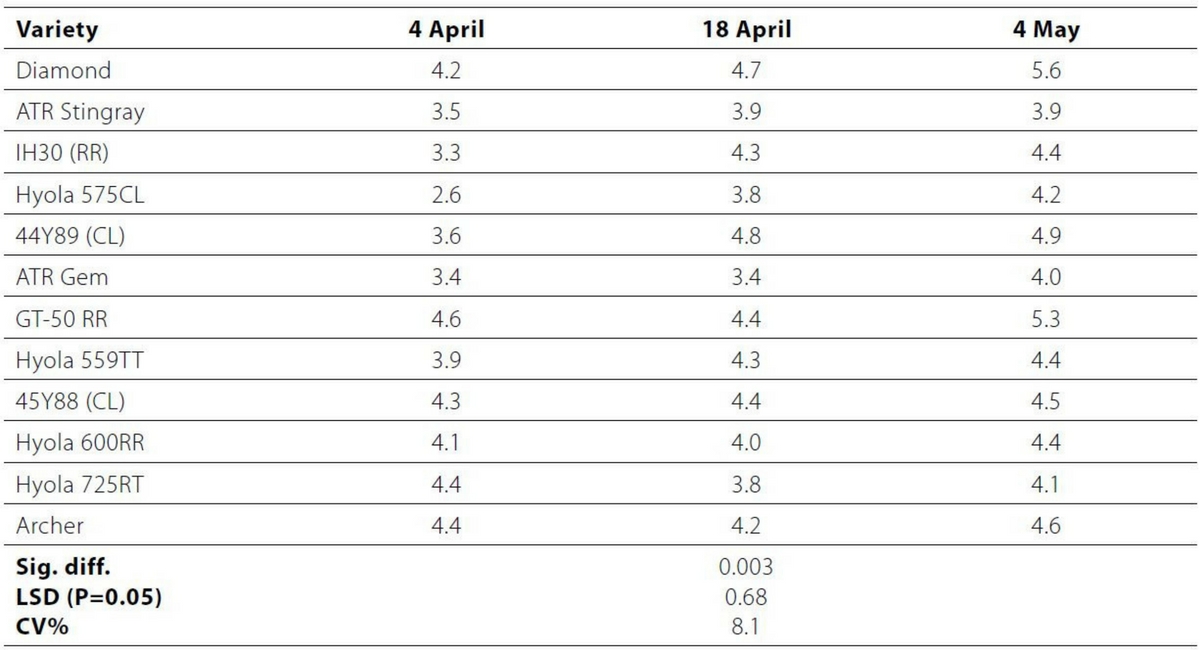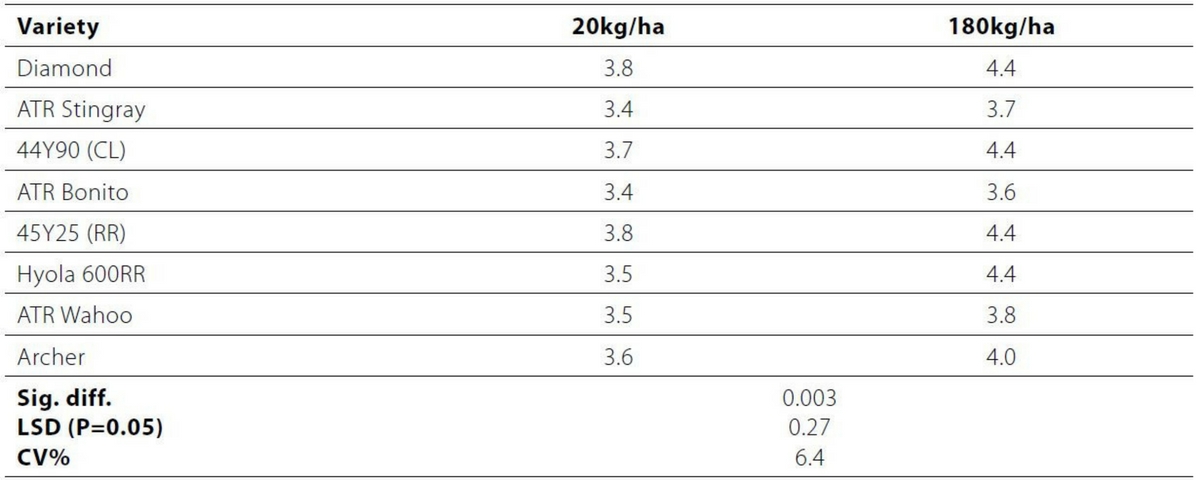Take home messages
- Ensure varietal phenology and sowing date are matched so that canola flowering starts at the right time for your region.
- Choose varieties carefully for sowing early as phenology differences are amplified when sowing occurs in early-mid April.
- Hybrid varieties responded better than open-pollinated triazine tolerant varieties to high rates
of nitrogen.
Background
Strict weed control and prudent stubble management combined with increasing summer and early autumn rainfall have created more opportunities to sow canola earlier than traditional sowing dates of 25 April.
Knowing how your variety responds to different environmental conditions will allow you to sow the variety at the appropriate time to target the optimal start of flowering (OSF) date. Managing the varieties phenology will be based on many factors such as solar radiation, temperature, moisture and nutrition. OSF dates are when flowering should be targeted to start (defined as when 50% of plants have one open flower). For canola (like most crops), OSF dates are a balance between minimising the stresses of heat, frost, drought and disease; while also maximising the crops ability to grow a high grain yield potential.
Aim
To determine the optimum phenology and plant type of canola for sowing early (early to mid-April) and at traditional sowing times (25 April). Trials were sown over three seasons to evaluate the response of a range of canola varieties to sowing date (three in 2015 and 2016, two in 2017) and nitrogen rate (in 2017 only).
Paddock details
| Location and year | 2015 Horsham | 2016 Longerenong | 2017 Longerenong |
| Crop year rainfall (Nov-Oct) | 228mm | 466mm | 424mm |
| GSR (Apr-Oct) | 125mm | 373mm | 303mm |
| Soil type | Clay | Clay | Clay |
| Paddock history | Wheat | Beans | Lentils |
Trial details and inputs
| Location and year | 2015 Horsham | 2016 Longerenong | 2017 Longerenong |
| Crop type | Canola | Canola | Canola |
| Treatments | 12 varieties x 3 TOS | 12 varieties x 3 TOS | 8 varieties x 2 nitrogen treatments x 2 TOS |
| Sowing date | 14 April, 29 April, 15 May |
4 April, 18 April, 4 May |
8 April, 28 April |
| Replicates | Four | Four | Four |
| Available nitrogen (0-100cm) | 125kg/ha | 87kg/ha | 77kg/ha |
| Plant available water (0-100cm) | 7mm | 51mm | 118mm |
| Average trial yield (t/ha) | 0.1 | 4.1 | 4.3 |
| Fertiliser (kg/ha) | Granulock Supreme Z @ 55kg/ha + urea @ 230kg/ha | Granulock Supreme Z @ 60kg/ha + SOA @ 90kg/ha + urea @ 190kg/ha |
Granulock Supreme Z @ 90kg/ha + SOA @ 95kg/ha over whole trial + urea @ 350kg/ha on high nitrogen rate treatments |
| Herbicide, insecticide and fungicides |
Managed to best practice | ||
Method
Trials were established with 10mm of dripper irrigation concentrated on the sowing row to achieve consistent germination at each sowing time. On average, the plants germinated seven days after irrigation.
The trials were all sown as a split-plot design, with variety (and nitrogen combinations in 2017) randomised within sowing date blocks. Flowering date was monitored and recorded when 50% of plants had one open flower. Grain yield assessments were made through threshing the dry hand cuts of above ground plant material in either 3x1m² (2015) or 2x1m² (2016 and 2017) sections of each plot. Oil concentration was measured using Near Infra-Red (NIR) analysis.
Results and interpretation
Diamond was the fastest variety to start flowering in both of the trials it was sown (Table 1). From the early sowing dates, it flowered 64 days before Archer in 2016 (sown 4 April) and 34 days before Archer in 2017 (sown 8 April). IH30 (RR) and ATR Stingray were both also very fast to flower. Archer was the slowest variety to start flowering in each trial. Other hybrids that were relatively slow to flower included Hyola 600RR, Hyola 750TT, Hyola 725RT and 45Y25 (RR). ATR Wahoo was the slowest of the open-pollinated triazine tolerant varieties.
Table 1. Start of flowering date (50% of plants with one open flower) of canola varieties
planted at three (2015 and 2016) or two (2017) sowing dates at Horsham (2015) and
Longerenong (2016 and 2017).
Grain yield
Due to very dry conditions in 2015, the average grain yield was only 0.11t/ha with little meaningful differences between varieties. The remainder of this paper focusses on the yield of the trials from 2016 and 2017.
In 2016 there was an interaction between variety and sowing date meaning that varieties reacted differently in response to changing sowing date. Fast varieties such as Diamond, IH30 (RR), Hyola 575CL and 44Y89 (CL) were penalised when sown early, with their highest yield coming from sowing on 4 May (Table 2). These fast varieties flowered too early from the 4 April sowing date and were penalised from a combination of higher disease pressure, potentially some frost damage and a general lower yield potential from early flowering (due to lower incoming solar radiation in mid-winter). The slower varieties in the trial – Archer, Hyola 725RT, Hyola 600RR and 45Y88 (CL) had more consistent yield across sowing dates but still lower yields than the fast variety Diamond from the 4 May sowing. GT-50 was also relatively high yielding at all sowing dates.
There was minimal effect of sowing date on oil concentration in 2016 but there were large differences between varieties. Hyola 559TT (45.0%), GT-50 (44.7%) and Hyola 600RR had relatively high oil concentration, whereas IH30 (RR) (39.8%), Diamond (40.7%) and Archer (40.7%) had relatively low oil concentration (data not shown).
Table 2. Grain yield of twelve canola varieties sown at three sowing dates at Longerenong, 2016.
There was no effect of sowing date on grain yield in 2017 as there was a much wider window for flowering to occur due to lower disease pressure, little frost (at this site) and likely a brighter winter with higher levels of incoming solar radiation (energy for the crop). There was however, an interaction between variety and nitrogen application (Table 3). For the five hybrid varieties Diamond, 44Y90 (CL), 45Y25 (RR), Hyola 600RR and Archer there was an average grain yield increase of 0.7t/ha from increasing nitrogen from 20 to 180kg/ha; however the increase for the open-pollinated triazine tolerant varieties ATR Stingray, ATR Bonito and ATR Wahoo was only (on average) 0.2t/ha.
There were only very small differences between the oil concentration of different varieties in 2017; however there was a significant oil reduction at the high N rate, with oil declining from an average of 45.1% at the 20kg N/ha rate to 42.8% at the 180kg N/ha rate. To keep this oil reduction in perspective though, at a grain yield of 3t/ha (42% oil) and canola at $500/t, a 10% yield increase would return as much extra income as an oil increase from 42% to 48.7%.
Table 3. Grain yield of eight canola varieties with two rates of nitrogen applied at
Longerenong, 2017.
Commercial practice
Sowing date and varietal phenology of canola need to be matched so that flowering occurs at the right time to help optimise grain yield. Canola varieties differ markedly in their phenology response to early sowing with the same varieties that flower across a narrow window (days) from an early May sowing likely to flower over a much wider window (weeks) from early April sowing.
In 2016 grain yield was lower for treatments that flowered in June or July compared with treatments that flowered in August. This trial is backed up by simulation modelling available in the eBook ‘Ten tips for early-sown canola’ (GRDC 2017), which gives a recommended start of flowering date for Horsham of 7 August.
Once sowing date and phenology is matched there is the need to ensure sufficient fertiliser is applied to canola to optimise grain yield. Hybrid varieties responded strongly to applied nitrogen in 2017, with an extra 0.5t/ha yield increase over open-pollinated triazine tolerant varieties where nitrogen was increased to 180kg/ha. Therefore, for growers looking to achieve a target yield of 4t/ha, the main factors to improve the likelihood of success include matching varietal phenology with sowing date, ensure the crop has adequate nitrogen supply and choosing hybrid varieties.
On-farm profitability
The increased response to the high rate of N from hybrids compared with OP TT varieties (0.7t/ha versus 0.2t/ha) meant that there was a profitability benefit of growing hybrid canola over OP canola in this trial. Allowing for seed costs, hybrids were close to $100/ha more profitable than OP TT varieties at the low rate of N but where N rate increased to 180kg/ha, the profitability of hybrids increased by $131/ha but reduced by $118/ha for OP TT (Table 4).
The price received by growers for canola is affected by the oil concentration. This trial showed that yield is a greater driver on profitability than oil (especially with hybrids) with a higher profit in the high N rate despite the drop in oil from 45.2 to 42.9%. At a grain yield of 2.5t/ha and with canola price at $500/tonne, a 10% increase in grain yield would give the same gross economic return as an oil increase of 6.7%.
Table 4. Grain yield (t/ha), oil concentration (%) and gross income ($/ha, assuming canola price of $500/tonne + oil bonus) of hybrid (all non-TT) and open-pollinated triazine tolerant (OP TT) with two nitrogen rates. Partial gross margin calculated as gross income minus seed (Hybrid $25/kg, OP $5/kg @ 3kg/ha) and fertiliser costs ($460/t).
References
GRDC 2017, ‘Ten tips for early-sown canola’
Acknowledgements
This research was funded by the GRDC ‘Optimised Canola Profitability’ project (CSP00187) with project partners NSW Department of Primary Industries, CSIRO and SARDI.
This report was funded by BCG members through their membership.




